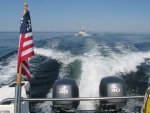capt. meares
New member
I was able to get out and do some extensive ocean time yesterday here in Tillamook. The bottom fishing was great and I limited in less than an hour. I then had a lot of time on my hands to play around until the tide swung and the bar was smooth enough to return. I am more than pleased at how well she handles in on coming swells. I have read lots on how the C-dory hull glides through the water, but had no idea how smooth of a ride it really was until yesterday. Right at about 15 mph, was the sweet spot.
Coming from the other direction, down the swells was a little different ball game than I am used to, compared to my old aluminum 18 footer. It really does squirrel tail a lot and slip around all over the place. I guess this is pretty normal with all dorys'. I am wondering what I can do to get accustomed to this. Has anyone else made the switch like me and been a little surprised? Is it better to slow down, or the more power the better? Should I consider twin 40's instead of a 90 when I repower in the spring or does it not make any difference? Thanks.......
Coming from the other direction, down the swells was a little different ball game than I am used to, compared to my old aluminum 18 footer. It really does squirrel tail a lot and slip around all over the place. I guess this is pretty normal with all dorys'. I am wondering what I can do to get accustomed to this. Has anyone else made the switch like me and been a little surprised? Is it better to slow down, or the more power the better? Should I consider twin 40's instead of a 90 when I repower in the spring or does it not make any difference? Thanks.......

